
This week's installment keeps us in Korea, but might be better titled “Ethnic Drinking 101”, since the bulk of the writing this week involves getting your Korean drink on. Koreans don't drink without eating, though, which means there are a lot of bar snacks, and they aren't your typical pretzels either. We'll delve a little bit more deeply into one of those bar snacks (fried chicken) and then close for now with a one-bowl lunch that's spicy, satisfying and good for you.
]
Soju and anju
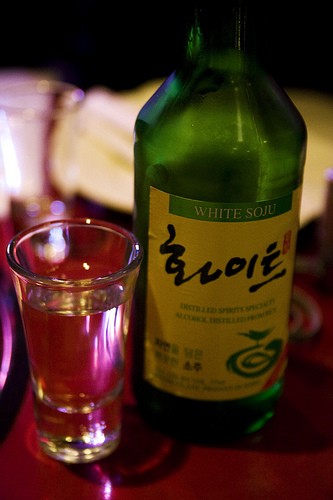
Koreans enjoy going out to drink as much as anyone else. Social
evenings are arranged by companies, by groups of friends, and even by
families. Bars stay open quite late (except where prohibited by
buzz-killing local liquor laws) and everyone takes the opportunity to
let their hair down a little while drinking an astonishing amount of
soju.
Soju is Korean vodka, a clear spirit distilled from rice, potatoes or
yams. It's not nearly as strong as vodka (usually 40-50 proof, whereas
vodka is normally 80 proof). When drunk by itself it has, shall we say,
an unpleasant aftertaste, but adding the smallest amount of any flavor
will kill the aftertaste. Some Korean bars will give you whole lemons
with bottles of soju. Use the bottle cap to break into the lemon, then
squeeze the juice into the shotglasses. A couple of drops per glass
will suffice to take the harsh edge off.
I am, I am somewhat consternated to say, an expert on soju. I had my
bachelor party at a bar in Koreatown and drank so much that my wife
worried that I'd miss the wedding due to alcohol poisoning. Ah,
youth… I can barely get through 20 shots of soju without being
besottedly drunk these days.[
If you're not interested in proving your virility, you can order
flavored soju in many places. There will be a range of flavors,
generally including green apple, lemon, melon and strawberry. The
mixers are typically mixed half-and-half with soju and drunk in
similar-sized shots, which lessens the alcoholic effect considerably
(but do think about all the sugar you're having). Try yoghurt flavor,
which is made with a drink a lot like Calpico; it's surprisingly good
and not at all like having a Dannon daiquiri.
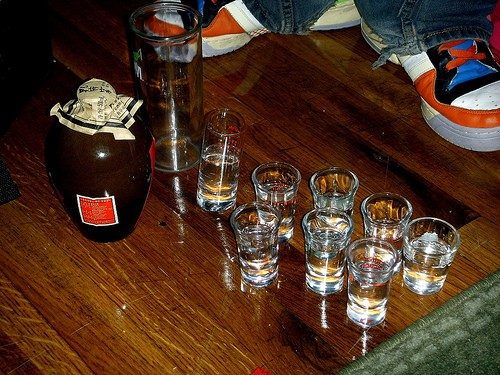
Other common drinks are baekseju (ginseng rice wine) and bokbunja
(raspberry wine). Koreans are also great drinkers of beer (called
maekju, pronounced “make joo”); Korean beer is very light, carbonated
and refreshing. It tends to be lower in alcohol. Common brands are Hite
(pronounced “height”) and O.B., but you may also see Japanese brands
such as Kirin available. The Korean equivalent of the boilermaker or
sake bomb is called poktanju (literally, “bomb drink”); drop a shot of
plain soju into a glass of beer and drink both together.
Some hints on Korean drinking etiquette:
- It's considered good manners to fill others' cups, so your cup will likely be kept full if you are out with a group of Koreans.
-
When filling cups, either support the pouring arm's wrist with the
non-pouring hand or lay your non-pouring arm across your chest or
stomach (if it helps, think of it as a gift given with two hands). -
If a social superior (your boss, an older person, the host, etc.) is
pouring for you, hold the glass with one hand supporting the other
wrist. -
You might see people turning their heads to drink; it's considered
polite to turn away from one's social superiors while drinking the shot. - Most websites give “cheers” as gunbae, kompae or some similar calque of
the Japanese “kampai”. You'll find you get more smiles if you say
“dipshida”, which is a native Korean word and means “drink it all”, or
“one shot!”, which is a challenge to knock the whole shot back at once.
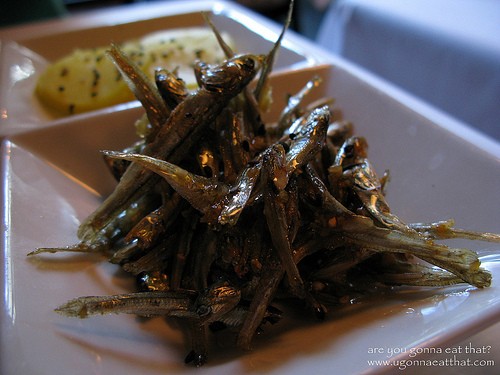
It's considered borderline alcoholism to have alcohol with no food, so
at least there will be peanuts (often boiled, Southern American-style)
or pickles. As you spend more money, you may find complimentary dishes
of anju being brought to you. This is called “service”, as in “We had
to spend $100 before they started giving us 'service'.”
In addition, you can order bar snacks, called anju in Korean. Anju are
sometimes on a menu but are more likely to be on papers on the wall,
written only in Korean. If you see a bunch of papers with Korean
writing and prices, those are the anju. They're typically fairly cheap, since bars make money on liquor, not food. Common anju are yangnyeom dak
(fried chicken–see the next page), nakji bokkeum (octopus in
gochujang), dubu kimchi (tofu and kimchi), fruit, fried or dried fish such as anchovies, sweet potato fries
covered in sugar, haemul p'ajeon (seafood pancake) or ddukbokki (spicy
rice cakes). If you're adventurous, try soondae (blood sausage).
One note about service: Korean bars sometimes are confused by attempts to
split the bill, because normally one person hosts the party and the
invitees respond by inviting the host to be their guest at a later time.
Where to get it: The bad news is that OC's Korean bars pale in
comparison to the massive competition in LA's Koreatown; that said, if
you have to get your soju on, try Jang Toh (9872 Garden Grove Blvd.,
Garden Grove). Past Memories (9252 Garden Grove Blvd., Garden Grove) is
a restaurant that doubles as a soju bar.[
Korean fried chicken
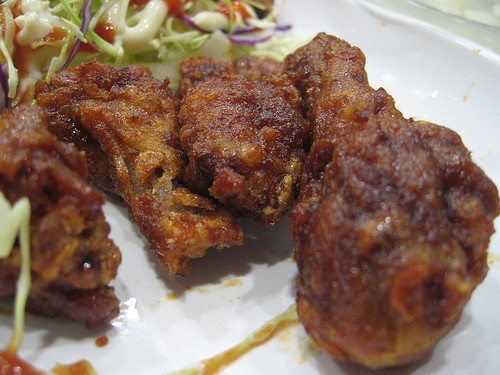
Big deal, right? Fried chicken is fried chicken, right? Anyone who's
ever been to a bar has had Buffalo wings and anyone who's ever been to
the South has had the last word in fried chicken, yes?
No. Korean fried chicken (yangnyeom dak, if you insist on ordering it in Korean) is
just plain different. The skin is amazingly crispy, while the chicken
is the moistest you'll ever have in a piece of fried chicken. The
chicken pieces are scored so that the schmaltz melts off,
then dredged in flour and run through a very thin batter (both
unsalted) and deep-fried twice.
The pieces are then normally dipped in sauce, like Buffalo wings. Spicy
sauce is the most common seasoning, though a popular alternative is a
vampire-repelling garlic sauce spiked with soy sauce for extra
saltiness. Drink fizzy Korean beer or soju with this dish.
This dish used to be only sold as street food or anju, but lately restaurants have opened
specializing in only this dish. If you go, expect mostly wings and
drummettes; the style of cooking doesn't lend itself to the Bo
Derek-esque breasts and the Julie Newmar-esque legs of American
chickens. If you're lucky, they'll have smaller Asian chickens and you
can have the whole chicken.
Where to get it: Kyochon (12840 Beach Blvd., Stanton), a popular chain in Korea, had lines out the
door when it opened. Its chief competitor bears a name that can't be
said while drunk (you'll collapse into giggles), Pizza and Chicken Love
Letter (2600 Alton Pkwy., Irvine; 8891 Garden Grove Blvd., Garden Grove).[
Bibimbap
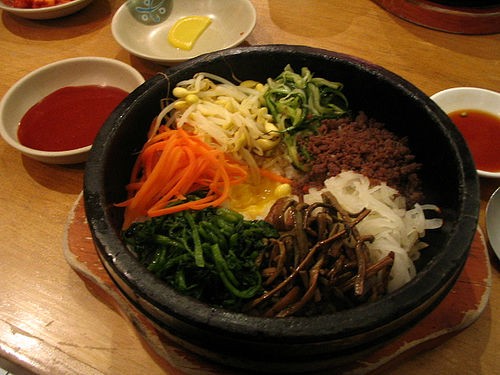
Bibimbap (spelled any number of ways) means mixed (“bibim”) rice
(“pap”). It's steamed rice with a variety of toppings: protein of some
kind and various julienned vegetables such as cucumber, carrots,
squashes, burdock root and mushrooms (often black fungus). If you get
lucky, you will find bellflower root or edible lily bulb and kim
(Korean-style dried seaweed, which may or may not be toasted like
Japanese nori). Nearly all bibimbap contains sprouts. Protein is
usually thinly-sliced beef, but it can be tofu or occasionally raw fish
(in which case it is called hwedupbap, raw fish rice. Hwedupbap is
somewhat like Japanese chirashi sushi, but tends to be bolder-flavored.
Bibimbap is always served with a big squeeze bottle of gochujang, chile
and fermented soybean paste. Add gochujang to taste, then mix all the
ingredients together with your chopsticks and spoon; eat the food with
your spoon. Bibimbap is one of the dishes that tends to come with fewer
banchan; often just kimchi and maybe some sesame spinach.
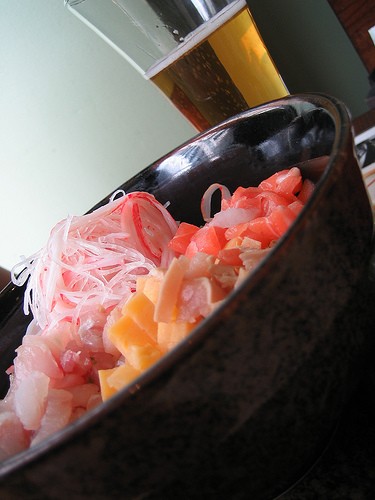
Most places in Southern California serve bibimbap in the dolsot (stone
pot). This creates a slightly crunchy crust on the rice that touches
the hot stone and also cooks the gochujang slightly, caramelizing it a
bit and lending a very subtle sweet, smoky taste that some love and
some hate.
Bibimbap is best when an egg yolk is cracked into the dolsot and mixed
with the rice, creating a slightly creamy texture. The trend in
quasi-Korean places lately has been to top the dish with a fried egg,
which works fine if the egg is fried correctly; sadly, most places
can't fry an egg very well, and so the yolk cooks through.
Where to get it: Just about anyplace will make it, but the best
bibimbap in Orange County isn't at a Korean restaurant at all, it's at
Tsuruhashi (18798 Brookhurst St., Fountain Valley), a Japanese yakiniku
place that also serves fantastic prime and American Kobe beef to grill
at your table. You will have to ask for it in the dolsot if you want
it, and you will have to insist that you can mix it up yourself, but it
is outstanding. Another good location is Sobahn Express in Diamond
Jamboree (2600 Alton Pkwy., Irvine, in the H-Mart grocery store). If
you insist on Korean sit-down, Chae Bahn in Diamond Jamboree (2750
Alton Pkwy., Irvine) will do you fine. Random fact: one of the best
coach-class airline meals is the bibimbap served on Korean Air.
Next week is a one-week trip to one of my favorite cuisines: Ethiopian. Have a great weekend and stay tuned!


CBD exceeded my expectations in every way thanks https://www.cornbreadhemp.com/blogs/learn/hemp-vs-marijuana . I’ve struggled with insomnia looking for years, and after infuriating CBD because of the prime age, I at the last moment knowing a complete evening of relaxing sleep. It was like a bias had been lifted off my shoulders. The calming effects were calm after all profound, allowing me to meaning off naturally without sympathies woozy the next morning. I also noticed a reduction in my daytime anxiety, which was an unexpected but receive bonus. The partiality was a fraction earthy, but nothing intolerable. Whole, CBD has been a game-changer for my nap and uneasiness issues, and I’m appreciative to procure discovered its benefits.